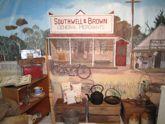McDonald, Kate
Family background
Catherine Ann 'Kate' McDonald was born in 1866, sixth of ten children to farmer Coll McDonald and Ellen nee Connelly, the family then living at Burra near Queanbeyan. Just prior to Kate's birth, persistent drought leading to crop failure and cattle death, put her father into voluntary sequestration. He then became a labourer to support the family. In 1871, as Kate reached school age, she was able to attend the new half-time McDonald's Flat School, conducted from her family home.
In 1872 the McDonald's situation improved with Kate's father resuming farming after inheriting property at Royalla. Within three years, the family moved to Queanbeyan where Coll McDonald ran a public house from home ['Queanbeyan Age', 13 October 1875, p. 2]. This enterprise only lasted a few years after which he resumed work as a labourer, being again forced into insolvency. In 1884 he secured the Queanbeyan to Uriarra mail delivery contract, providing some financial security, and two years later Kate began teaching, her salary doubtless a welcome supplement to the family income.
Black Creek Provisional School
In January 1886, 20-year-old Kate was appointed to Black Creek in the Queanbeyan district, which was then struggling to maintain sufficient attendance. She appears to have settled to her duties and was permitted a classification examination in July 1887 but was unsuccessful, the concurrent death of a sibling perhaps a contributing factor. In her third year at Black Creek, Kate received a poor school inspection report which she attributed to her pupils' irregular attendance and 'an insufficient supply of school materials'. A month later she applied for removal, her salary having been reduced by the school's low attendance to a point 'scarcely sufficient to defray the expenses of board and lodging'. When this appeal was futile, Kate tendered her resignation to seek better remunerated employment.
Moppity Public School
In July 1891 Kate returned to teaching with appointment to Moppity near Young, coincident with her father being again declared insolvent. After a year she asked for removal as she was unable to get convenient lodgings, 'nor a paddock for a horse', so walked three miles to and from school daily. Although recommended for consideration, action was deferred pending a school inspection. Before this could happen, however, Kate's health declined and she had two months leave for anaemia and 'general debility', during which time Moppity School was closed. The anticipated inspection occurred soon after her return to duty and whilst asking that allowances be made due to her extended absence, significant defects in pupils' attainments were nonetheless recorded. Shortly after this, Queanbeyan MP, Mr Edward O'Sullivan, wrote on behalf of Kate's parents, asking that she be moved closer to home, but this request was denied due to her poor inspection report. She continued at Moppity another six months until requiring extended leave for 'anaemia & chronic laryngitis', returning to her family home to recuperate, but eventually resigning on the understanding she could apply for re-employment after six months.
Glenwood Public School
In May 1894 Kate returned to teaching with temporary appointment to Glenwood Public. As with her previous appointment, she was forced to board miles from school. After three months on duty she required leave due to laryngitis and neuralgia, her ill health not surprising given her daily treks and the draughty condition of the school, worsened by a scant firewood supply and faulty chimney. After six months at Glenwood, Kate unsuccessfully asked for removal, reporting that the attendance was down as the family she previously boarded with had withdrawn their children 'through feelings of malice toward me for leaving their house'. A few months later, as the same family continued to keep their children out of school, Kate asked if they could be compelled to send them. Accompanying her report to the Department was a letter from a school board member, advocating an exchange of teachers between Jeir and Glenwood to resolve the situation, and shortly after this swap was approved on the basis that Glenwood would be better served by a male teacher.
Jeir Provisional School
Kate took charge of Jeir at the end of June 1895, her appointment seen as temporary. After regular inspection at the end of the year, she was asked to explain the poor student attainments which she attributed to irregular attendance and examination nerves, as well as her own illness. While this was accepted, she was told improvement was necessary, however Jeir was soon converted to half-time so she was relocated.
Googong Public School
On 17 December 1895 Kate took temporary charge of Googong which had been two months without a teacher while its future was considered due to declining numbers. After she had been four months on duty, Edward O'Sullivan MP, being made aware that Kate was obliged to lodge three miles from school, wrote to the Department seeking an alternate position for her. Apparently, the Googong residents who were all Protestant, resented Kate's Catholic background. Meanwhile her difficulties increased when the owner of the school building refused her access, claiming rental arrears, resulting in the Department's prompt closure of the school.
Ironbong Provisional School
In July 1896 Kate took temporary charge of Ironbong near Cootamundra. While her accommodation situation improved with her lodgings reportedly convenient to school, her salary remained low due to her lack of qualification and the small school size. At inspection in 1897, defects were recorded and her explanation considered unsatisfactory, so it was recommended she be 'censured severely'. Shortly after this she notified her intention to resign on account of marriage, but asked to withdraw this two weeks later. She was informed, however, that she was 'ineligible for any future employment' due to her 'inefficient' teaching record. Her resignation therefore became effective at the end of March 1897, after eleven years' service across six schools.
Later life
Two months after resigning Kate married John McGuigan of Jingera (near Captain's Flat). A year later she had a daughter and the family moved to Majors Creek where her husband worked as a miner. Sadly in 1902 Kate, aged 36, 'who had been ailing for a few weeks ... died quite unexpectedly', the cause understood to be heart disease ['Braidwood Dispatch and Mining Journal', 24 December 1902, p.2]. After a well-attended funeral, she was buried in an unmarked grave in Majors Creek Cemetery.
[Biography prepared by Joanne Toohey, 2025. Sources include NSW school teachers' rolls 1868-1908, NSW school and related records 1876-1979, historic newspapers and magazines, NSW births, deaths and marriages index, NSW Probate records & Insolvency files, and 'Early Education and Schools in the Canberra Region', (1999) by Lyall Gillespie.]
Schools
- Glenwood
05/1894 - 06/1895 - Jeir Public School
06/1895 - 12/1895 - Googong
01/1896 - 07/1896

